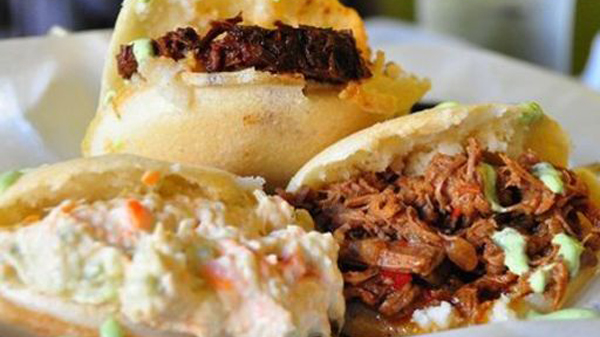we enter the theme of gastronomy
the popular Venezuelan arepa
The arepa is a food of pre-Columbian origin of Colombia and Venezuela, made with a mass of dry ground corn or precooked corn flour, circular and flattened. It is consumed in a traditional way in the cuisines of Colombia and Venezuela. Due to the migratory exchanges with Venezuela, it has also spread to the Canary Islands.
The arepa was prepared and consumed by the aborigines from pre-Columbian times in the current territories belonging to Colombia and Venezuela.13 Indigenous food customs are seen in corn-based criollo dishes such as arepa.14
The introduction of the arepa to their villages was a result of climate and corn production. Corn was an important element in the diet of the Indians. In these regions, the cultivation of corn was diverse. In the territory corresponding to present-day Venezuela, the tribes cultivated nine types of maize: "white, for roasting, black and white, long, ash-colored maize, and the one called by the Spaniards Cariaco corn, while the cumanagotos called it an erepa." 15
Indigenous mythologies make references to maize or corn and describe these as an "offering that the gods made to men." 16 José de Acosta, a Spanish philosopher and Jesuit traveler in the sixteenth century, contrasted corn with wheat, yuca and cazabe by saying that this is "thicker and warmer and breeds blood." 16 He also mentions that the arepa has "a solar disk" form and the budare is like "sacrificial stone or clay for the rite of the first bread. "16 Pedro Ruiz de Tapia, the king's accountant in Venezuela in 1548, points out that the arepas were rationed to the people; each Indian received three corn arepas a day for lunch and dinner.13
Traditionally, the preparation of arepas was reserved for women.17 First, they dipped the corn grains, removed the hulls from the grains and ground the grains into flour. Then, the flour was mixed with water to create a dough. With the dough balls were created, which were then flattened and cooked until the outside of the dough was cooked. The women used certain instruments to make arepas. In addition to fire, they used metates to grind and crush the corn and budares (baked clay grills) to cook the arepas.18 They made arepas approximately 1.5 centimeters thick and 10 in diameter and weighing about 250 grams. 19
Today, the arepa is considered a gastronomic icon of Colombia and Venezuela, and a common heritage shared by these nations. The arepa is a symbol of the indigenous tradition that is still present in these countries. However, the mode of preparation changed in 196019 with the introduction of precooked cornmeal that simplifies the process by making it unnecessary to soak and grind corn.20 Pre-cooked cornmeal is ready to prepare arepas. It is only necessary to mix water and a little salt to create the dough. The process takes around 5 to 10 minutes. When the dough is soft and moldable, you can create the shape of the arepas and cook.
Congratulations @mili85! You received a personal award!
You can view your badges on your Steem Board and compare to others on the Steem Ranking
Vote for @Steemitboard as a witness to get one more award and increased upvotes!
Congratulations @mili85! You received a personal award!
You can view your badges on your Steem Board and compare to others on the Steem Ranking
Do not miss the last post from @steemitboard:
Vote for @Steemitboard as a witness to get one more award and increased upvotes!